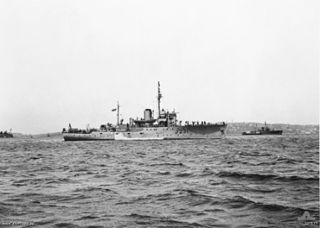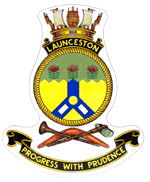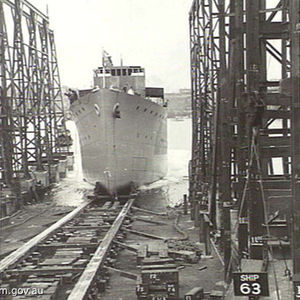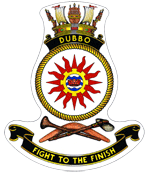
HMAS Broome (J191), named for the town of Broome, Western Australia, was one of 60 Bathurst-class corvettes constructed during World War II and one of 20 built for the Admiralty but manned by personnel of and commissioned into the Royal Australian Navy (RAN).

HMAS Cowra (J351/M351), named for the town of Cowra, New South Wales, was one of 60 Bathurst-class corvettes constructed during World War II, and one of 36 initially manned and commissioned solely by the Royal Australian Navy (RAN).

HMAS Deloraine (J232/M232), named for the town of Deloraine, Tasmania, was one of 60 Bathurst-class corvettes constructed during World War II, and one of 36 initially manned and commissioned solely by the Royal Australian Navy (RAN). In January 1942 she evaded an attack by the Japanese submarine I-124 north-west of Darwin and was jointly credited with the submarine's sinking after inflicting the initial damage. She was present at the bombing of Darwin and survived unscathed.

HMAS Echuca (J252/M252), named for the town of Echuca, Victoria, was one of 60 Bathurst-class corvettes constructed during World War II, and one of 36 initially manned and commissioned by the Royal Australian Navy (RAN).

HMAS Gympie (J238/M238), named for the city of Gympie, Queensland, was one of 60 Bathurst-class corvettes constructed during World War II, and one of 36 initially manned and commissioned solely by the Royal Australian Navy (RAN).

HMAS Horsham (J235/M235), named for the city of Horsham, Victoria, was one of 60 Bathurst-class corvettes constructed during World War II, and one of 36 initially manned and commissioned solely by the Royal Australian Navy (RAN).

HMAS Latrobe (J234/M234), named for the town of Latrobe, Tasmania, was one of 60 Bathurst-class corvettes constructed during World War II, and one of 36 initially manned and commissioned solely by the Royal Australian Navy (RAN).

HMAS Lithgow (J206/M206), named for the city of Lithgow, New South Wales, Australia was one of 60 Bathurst-class corvettes constructed during World War II, and one of 36 initially manned and commissioned solely by the Royal Australian Navy (RAN).

HMAS Stawell (J348/M348) was a Bathurst-class corvette named for the town of Stawell, Victoria. Sixty Bathurst-class corvettes were constructed during World War II, and Stawell was one of 36 initially manned and commissioned solely by the Royal Australian Navy (RAN).

HMAS Tamworth (J181/B250/A124), named for the city of Tamworth, New South Wales, was one of 60 Bathurst-class corvettes constructed during World War II and one of 20 built on Admiralty order but manned by personnel of and later commissioned into the Royal Australian Navy (RAN). Tamworth later saw service in the Royal Netherlands Navy (RNLN) and in the Indonesian Navy (TNI-AL).

HMAS Cairns (J183), named for the city of Cairns, Queensland, was one of 60 Bathurst-class corvettes constructed during World War II and one of 20 built for the Admiralty but manned by personnel of and commissioned into the Royal Australian Navy (RAN).

HMAS Wallaroo (J222), named after the town of Wallaroo, South Australia, was one of 60 Bathurst-class corvettes constructed during World War II, and one of 36 initially manned and commissioned solely by the Royal Australian Navy (RAN). Wallaroo was one of only three Bathursts lost during World War II; following a collision with US Liberty ship Henry Gilbert Costin on the night of 11 June 1943.

HMAS Bunbury (J241/M241), named for the city of Bunbury, Western Australia, was one of 60 Bathurst class corvettes constructed during World War II, and one of 36 initially manned and commissioned solely by the Royal Australian Navy (RAN).

HMAS Bundaberg (J231/M231), named for the city of Bundaberg, Queensland, was one of 60 Bathurst-class corvettes constructed during World War II, and one of 36 initially manned and commissioned solely by the Royal Australian Navy (RAN).

HMAS Fremantle (J246/M246), named for the port city of Fremantle, Western Australia, was one of 60 Bathurst-class corvettes constructed during World War II, and one of 36 initially manned and commissioned solely by the Royal Australian Navy (RAN).

HMAS Gawler (J188/B241/A115), named for the town of Gawler, was one of 60 Bathurst-class corvettes constructed during World War II and one of 20 built for the Admiralty but manned by personnel of and commissioned into the Royal Australian Navy (RAN). The ship was laid down by BHP at its Whyalla shipyard in early 1941, launched later that year, and commissioned in 1942.

HMAS Geelong (J201), named for the city of Geelong, Victoria, was one of 60 Bathurst-class corvettes constructed during World War II, and one of 36 initially manned and commissioned solely by the Royal Australian Navy (RAN).

HMAS Geraldton (J178/B242/A116), named for the city of Geraldton, Western Australia, was one of 60 Bathurst-class corvettes constructed during World War II and one of 20 built for the Admiralty but manned by personnel of and commissioned into the Royal Australian Navy (RAN).

HMAS Launceston (J179/B246/A120), named for the city of Launceston, Tasmania, was one of 60 Bathurst-class corvettes constructed during World War II and one of 20 built for the Admiralty but manned by personnel of and commissioned into the Royal Australian Navy (RAN).

HMAS Toowoomba (J157/B251/A125), named for the city of Toowoomba, Queensland was one of 60 Bathurst-class corvettes constructed during World War II and one of 20 built on Admiralty order but manned by personnel of and later commissioned into the Royal Australian Navy (RAN). The ship later served in the Royal Netherlands Navy (RNN) as HNLMS Boeroe.





















